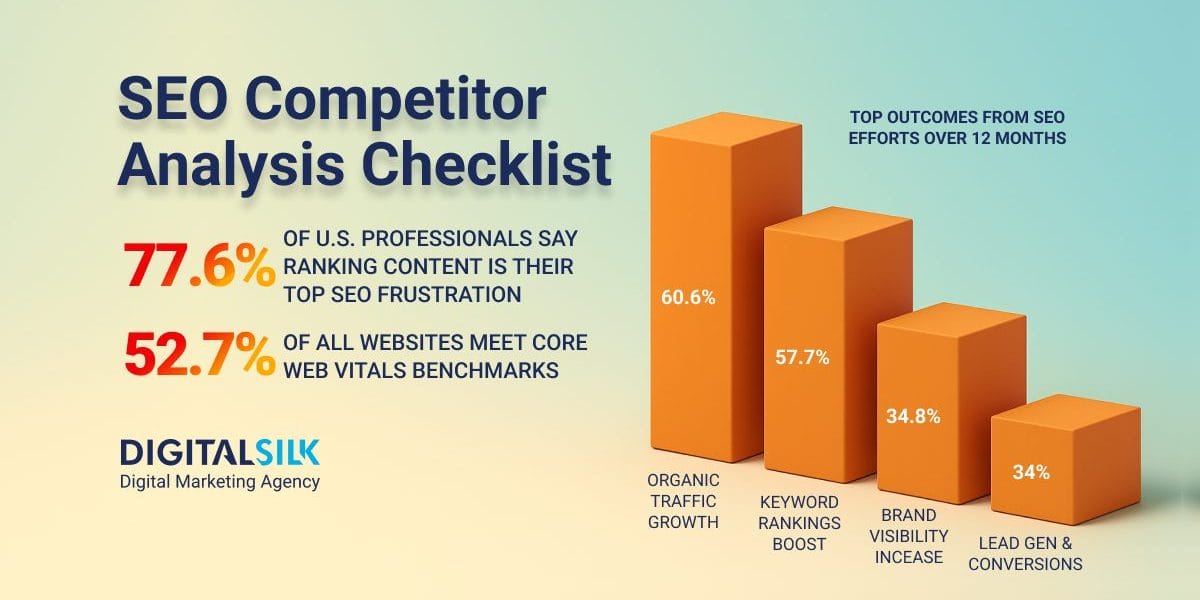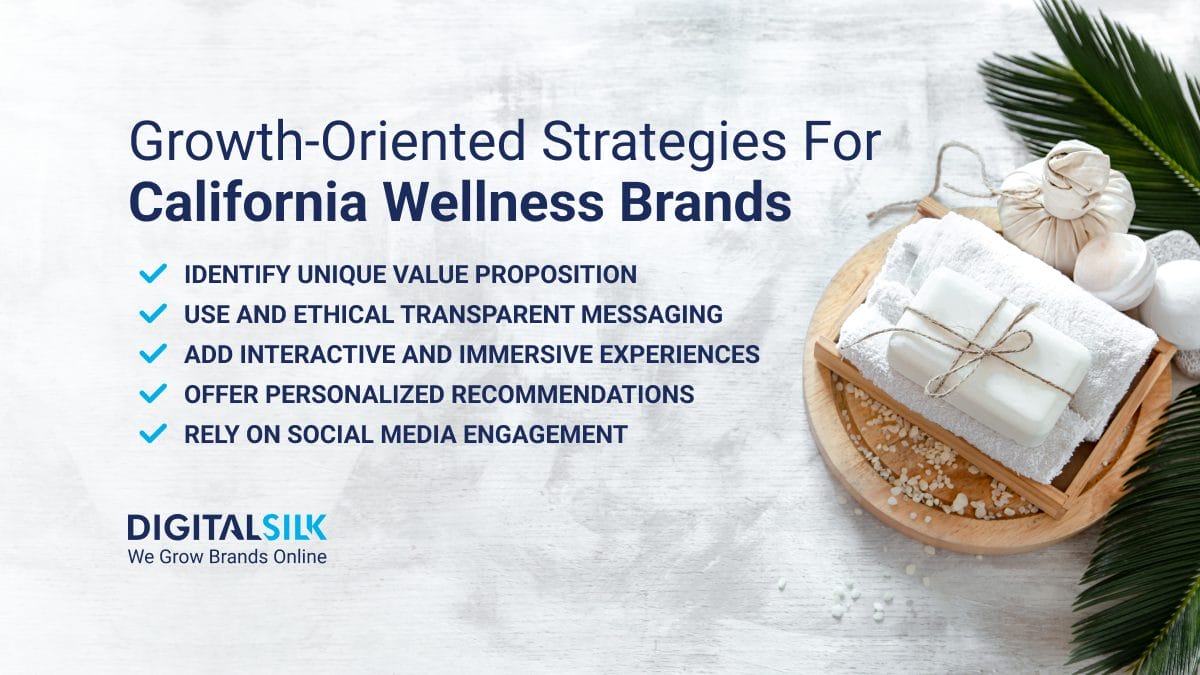SEO Competitor Analysis: Key Highlights
-
Competitors aren’t always obvious: Industry publishers, review sites and content hubs can outrank direct rivals for valuable keywords.
-
Keyword gaps reveal openings: Missed terms show where competitors capture buyers first, leaving room to reclaim lost traffic.
-
Plan for what’s next, not what was: Track AI-overview citations, video adoption and voice queries to reposition before the field shifts.
CEOs are investing heavily in digital marketing, yet many struggle to pinpoint exactly where competitors are capturing opportunities or eroding their market share.
Over the past 12 months, 60.6% of companies grew organic traffic through a defined SEO strategy, proving that visibility in search is increasingly the deciding factor in who gets discovered, trusted and chosen.
Competitive analysis is the starting point for creating that kind of strategy because it reveals how rivals are capturing attention and where opportunities are being lost.
Below, we outline the seven-step SEO competitor analysis that helps executives direct investment, outmaneuver rivals and secure long-term advantage.
How To Do A Competitor Analysis In SEO
With more than 5 trillion searches taking place on Google each year, the competition for visibility is constant and unforgiving.
Analyzing how competitors position themselves in search reveals both the tactics driving their growth and the openings you can use to shift the advantage.
The steps ahead outline the core strategies of an SEO competitor analysis to help you identify where rivals are winning, measure your own standing and decide where to focus resources for greater impact.
Step 1. Identify Your SEO Competitors
The majority of user clicks go to the top results on Google, with 27.6% going to the first result alone.
To compete, you need to know exactly who you are up against in search and these competitors aren’t always the same as the ones you face in the market.
Industry publications, review sites or content-driven companies may never sell what you do, but they can dominate rankings that matter to your buyers and redirect traffic that could have been yours.
The first option is to run manual searches for your target keywords, which gives you a first-hand view of who consistently shows up in front of your audience.
- Search for several of your most important keywords and note which domains appear at the top
- Watch for patterns across different keywords to identify the sites that repeatedly dominate
- Record these domains to create a baseline list of the competitors you are truly up against in organic search
Keep in mind that while this method is straightforward, it is time-consuming and unrealistic if you are tracking hundreds or thousands of keywords.
The second option is to use SEO competitor analysis tools, which automate the process and surface insights you cannot get manually:
- Semrush: identifies domains with the highest keyword overlap, estimates organic traffic and shows visibility across different markets
- Ahrefs: generates competitor reports with traffic share by domain, keyword gaps and ranking performance across search results
- Both platforms: reveal competitors you might not expect, such as publishers or niche content hubs and provide data to decide which domains matter most to your strategy
In Semrush, you can:
- Enter your domain in the Domain Overview
- Navigate to the Main Organic Competitors section for a ranked list of domains sharing the most keywords with you
- Compare traffic estimates and keyword overlaps to see which competitors are winning the rankings you want
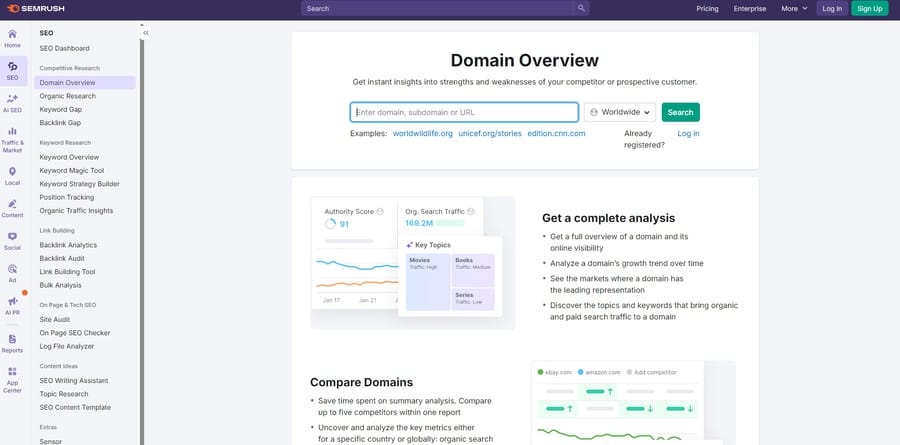
If you’re using Ahrefs, follow these steps:
- Enter your domain in the Site Explorer
- Open the Organic Competitors report to see websites ranking in the top 10 for the same keywords as yours
- Use Traffic share by domain and Keyword Gap to identify where competitors are outperforming you and which opportunities are still open
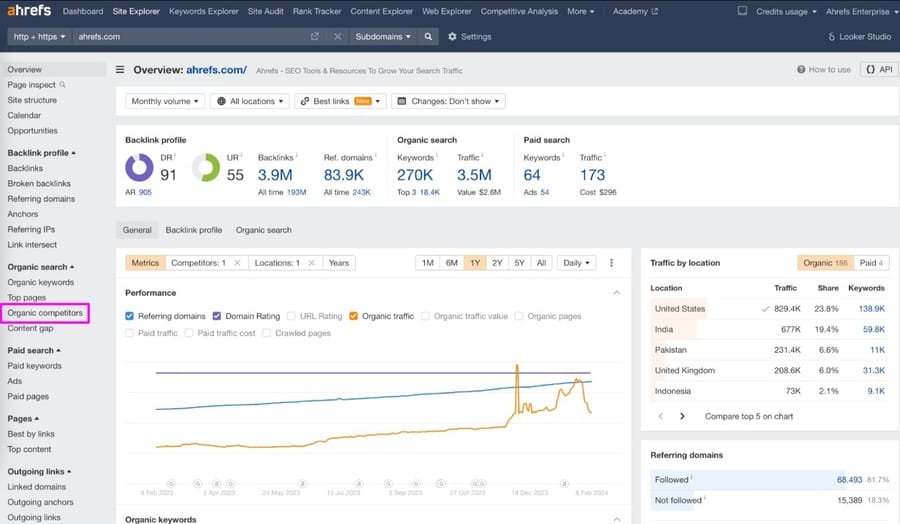
Once you know who you’re up against, the next question is: where are they capturing attention that you aren’t? That’s where keyword gap analysis becomes your most powerful lens.
Step 2. Analyze Keyword Gaps
Keyword rankings are the top metric used to measure SEO performance worldwide, with 20% of professionals citing it as their primary benchmark.
That tells you something important: what your competitors rank for directly defines who earns attention in search.
Content gaps, or the keywords your competitors rank for but you don’t, represent missed opportunities where others are shaping the conversation, capturing traffic and influencing your buyers before you ever appear on the page.
In Ahrefs, you can uncover these opportunities by:
- Opening the Competitive Analysis tool and entering your domain as the target
- Adding your competitors’ domains to run a comparison
- Using the Content Gap report and selecting “Main positions only” to filter out noise from SERP features
- Reviewing the missing keywords that are relevant to your business, prioritizing those with strong search volume and buyer intent
Here’s an overview of what the Content Gap report in Ahrefs looks like:
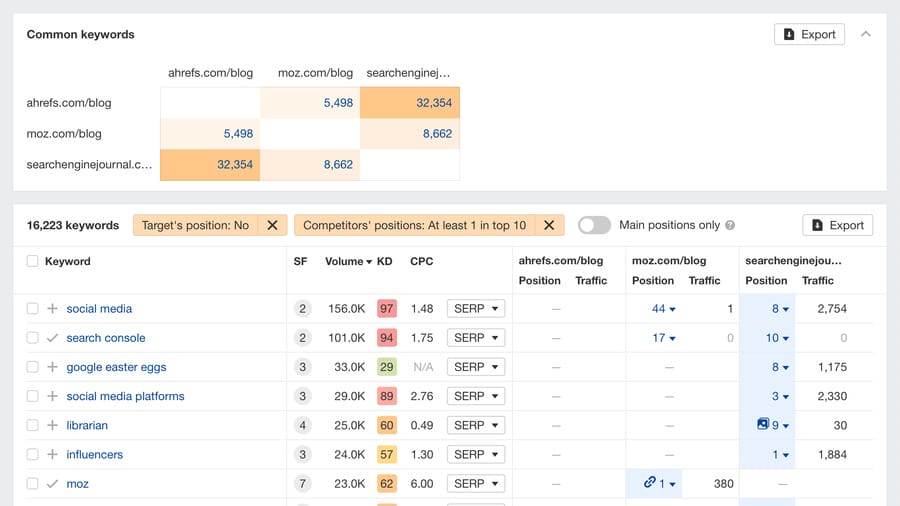
In Semrush, you can take a broader view of the competitive field by:
- Going to the Keyword Gap tool and entering your domain along with up to four competitors
- Applying the Missing filter to see the terms they rank for but you don’t
- Reviewing the results to identify where multiple competitors dominate and where the opportunities are open
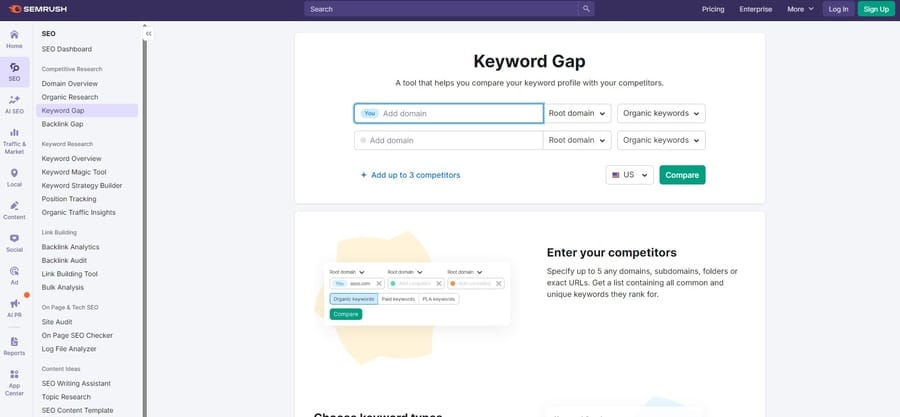
Once you generate these lists, the next step is to prioritize them using clear key performance indicators (KPIs) and filtering criteria that align with executive decision-making:
- Position: focus on keywords where competitors are already ranking in the top 10
- Volume: look at average monthly searches to gauge which terms drive meaningful visibility
- Keyword Difficulty (KD): concentrate on ranges marked “Very easy” to “Easy” where ranking potential is higher
- Intent: distinguish between transactional terms that drive sales and informational terms that support authority-building
- Topic relevance: apply advanced filters to highlight keywords tied directly to your products, services or market positioning
Step 3. Evaluate Content Performance
The overall content strategy is the leading SEO approach worldwide, with 16.7% of professionals ranking it as their top priority.
A competitor SEO analysis helps you evaluate how well competitors’ content performs, revealing not only which formats and topics attract the most traffic but also where opportunities exist to outperform them.
Key areas to examine when assessing competitor content performance:
- Content type: Determine what formats consistently deliver results for competitors. Are they publishing long-form guides, practical how-to articles, comparison pages, or product-driven content? If a specific type dominates the top results, it signals what resonates most with your buyers and where you may need to expand your own content mix.
- Quality and depth: Look at whether their content is well-researched, authoritative and up to date, or if it shows weaknesses like thin coverage, outdated references or keyword stuffing. Poor execution here opens a door for your business to create stronger, more useful material that wins both rankings and trust.
- Formats and media use: Check how competitors integrate video, imagery, infographics or data visualizations. These elements can improve engagement, but if poorly optimized they slow load times and frustrate users. Page experience directly affects rankings, so a competitor with heavy, unoptimized media may be vulnerable.
- Featured snippets and SERP features: Identify if competitors are winning featured snippets or other rich results. Since only one site can hold the snippet per query, knowing which terms they dominate helps you decide where to compete directly by producing clearer, more targeted answers.
- Readability and structure: Review how their pages are laid out. Is the content organized with clear headings and logical hierarchy, or does it appear as long unbroken text blocks? Readable, well-structured content can earn higher engagement and lower bounce rates, creating another advantage in rankings.
How to analyze performance using competitor analysis tools for SEO:
- In Semrush, the Organic Research report highlights competitors’ top-performing pages by estimated traffic and keyword coverage. Filtering by traffic share helps you identify which pages attract the largest audiences.
- In Ahrefs, the Top Pages report shows which competitor URLs bring in the most visits and from which keywords. This allows you to see not only what content drives results but also why it ranks where it does.
By combining these insights, you can see which competitor content sets the benchmark, where they fall short and where targeted improvements to your own strategy can shift visibility toward your business.
Step 4. Run Technical SEO Comparisons
In 2025, 19.1% of SEO specialists cited low confidence in deep technical SEO knowledge.
That gap matters because even if a competitor’s content is strong, weaknesses in speed, indexing or mobile experience can keep them from converting visibility into traffic.
An SEO competitor analysis checklist should always include a technical review, since rankings are shaped as much by site performance and usability as by the quality of the content itself.
- Core Web Vitals and site performance: Only 52.7% of websites meet Google’s Core Web Vitals benchmarks, which means nearly half of the web is underperforming on speed, responsiveness and stability. If competitors fall into that group, it’s a clear opening to outperform them with a faster and smoother user experience.
- Indexing and crawlability: Inspect competitor XML sitemaps and see which pages are being indexed. If rivals flag more pages for indexing that align with target keywords, it may reveal opportunities you are missing.
- HTTPS and security standards: HTTPS is used by 88.8% of all websites, making it the expected standard. Any competitor without full HTTPS coverage risks losing both credibility and rankings to those who have it in place.
- Mobile responsiveness: Test competitor domains with tools like Google’s PageSpeed Insights to assess mobile usability. Since Google relies on mobile-first indexing, a poor mobile experience can negate even the strongest desktop performance.
- Schema markup and rich results: Use tools like Google’s Rich Results test or Schema Markup Validator to check whether competitors have implemented schema to earn rich results such as FAQs, reviews or product highlights. If their listings stand out visually in the SERPs while yours do not, adopting schema is a direct path to improving visibility.
You can review your own site for free through Google Search Console, which provides reports on indexing, Core Web Vitals and HTTPS.
For deeper comparisons, use Semrush’s Site Audit or Ahrefs’ Site Audit to run crawls on competitor domains and measure technical performance side by side.
Step 5. On-Page Optimization Checks
On-page optimization is often overlooked, yet it directly shapes how search engines interpret and display your content.
Many of the most common SEO challenges stem from gaps in basic elements like titles, descriptions and internal linking, which can cost visibility even when content itself is strong.
Competitor analysis for SEO should therefore include a page-by-page review of how rivals handle these fundamentals.
Some of the key areas to review include:
- Title tags and meta descriptions: 92.6% of top-ranking pages include a title tag, and when one is missing Google replaces it with the H1 heading or rewrites it entirely. Reviewing how competitors craft their titles and descriptions helps reveal whether they are concise, keyword-focused and compelling enough to drive clicks.
- Keyword placement: Assess how competitors position target terms in titles, headers and early paragraphs. Strong placement signals relevance to search engines and often determines which pages hold rankings over time.
- URL structure and clarity: Review whether competitors are using clean, keyword-based URLs that provide context at a glance. Well-structured URLs make it easier for both users and search engines to understand and rank pages, while cluttered or inconsistent structures can weaken performance.
- Internal linking: Look at how competitors connect related content through links. A clear linking structure keeps visitors moving deeper into their site while reinforcing authority signals that search engines value.
You can do these checks manually by reviewing competitor pages in search results, but tools make the process faster and more consistent.
Semrush’s On Page SEO Checker or Ahrefs’ Site Audit can highlight missing tags, weak keyword placement and internal linking gaps so you can compare your site against competitors at scale.
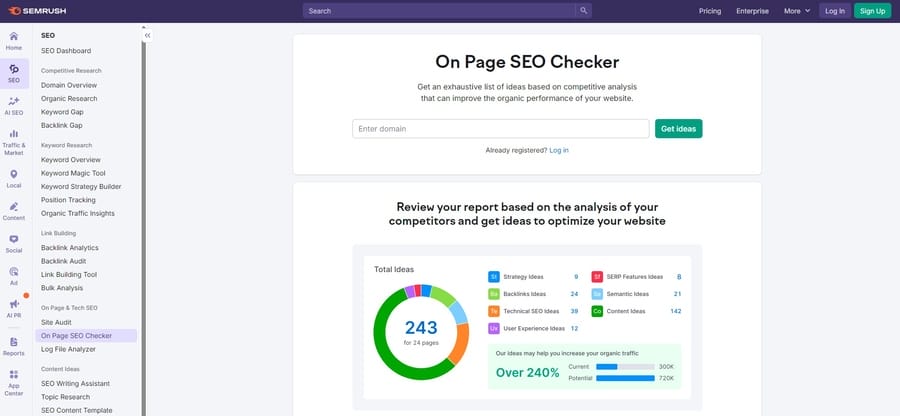
Step 6. Identify Backlink Gaps
Backlinks remain one of the strongest signals of authority in search, but they are far from permanent.
At least 66.5% of backlinks eventually break, while in 47.7% of cases, the linked page disappears entirely.
That makes link building less about chasing one-time wins and more about constantly spotting where competitors gain authority and where they lose it.
This step in competitor analysis for SEO helps you see which domains strengthen your rivals’ visibility and how you can redirect that authority toward your own pages.
It also highlights common mistakes in link building, like chasing low-quality sources or ignoring broken opportunities, both of which waste resources instead of optimizing marketing budget.
The key areas you should review include:
- High-authority domains: Spot sites that link to competitors but not to you. Semrush’s Backlink Gap tool highlights domains that connect to several rivals, making them prime targets for outreach since they already consider your niche credible.
- Backlink quality: Compare the authority, relevance and placement of competitor links. A single backlink from a respected publication or .edu page can outweigh dozens of links from weaker sites.
- Lost backlinks: Use Ahrefs or Semrush to track competitor backlinks that have recently disappeared. When the link came from a credible source, you can step in with updated or superior content and reclaim that authority.
- Content targets: Identify which competitor pages earn the most backlinks. If you do not have equivalent content, add it to your roadmap. If you do, compare side by side to see how your version can be strengthened to attract similar recognition.
- Mix of link types: Review how many competitor links are follow versus no-follow. A balanced mix suggests natural acquisition, while heavy reliance on weak or irrelevant sources is a red flag.
Google Search Console lets you track your own backlinks, but it doesn’t provide competitor data.
Instead, you can use Semrush’s tools to compare multiple domains and highlight the strongest opportunities ranked by authority.
Ahrefs adds further depth with detailed backlink profiles and lost link reports that reveal where competitors are gaining or losing ground.
Focusing outreach on domains that already link to your competitors is one of the most efficient ways to optimize your marketing budget and build lasting authority.
Step 7. Evaluate Emerging Trends & Future Threats
The growing use of AI is already reshaping how search engines display results, how users consume information and how competitors adapt their strategies.
In fact, 29% of SEO professionals point to generative AI as the leading reason for a shift in SEO worldwide, which makes future-focused monitoring an indispensable part of strategy.
Looking at SEO competitor analysis examples shows how quickly new tactics can shift visibility.
A rival experimenting with video content could gain stronger traction across search and social, while another optimizing for voice queries might capture traffic that peers overlook.
These patterns highlight how emerging formats create openings for organizations willing to move ahead of the curve.
To evaluate where competitors may already be moving, focus on the following areas:
- AI-driven SERPs: Generative AI is reshaping result pages by pulling information directly into summaries, leaving fewer clicks for traditional listings. Competitors that adapt their content to feed these models will gain visibility faster than those who ignore it.
- AI Overviews: Google’s AI Overviews now dominate the top of many results pages, often summarizing information without a click. Competitors whose content is cited here gain disproportionate visibility, so it is important to track which topics and formats Google is pulling into these summaries.
- Video adoption: Video is appearing more often in search results and gaining preference in discovery algorithms. If rivals are investing in video while your strategy remains text-heavy, they will dominate attention where it matters most.
- Voice search: With smart speakers and mobile voice queries on the rise, optimizing for conversational search is becoming more valuable. Competitors who align content with natural language queries can capture audiences you are not reaching.
- New content formats: From interactive tools to data visualizations, innovative formats drive links and engagement that plain text can’t match. Monitoring which experiments gain traction for competitors provides a roadmap for where to invest next.
Why An SEO Competitor Analysis Matters
Learning how to analyze your competitor’s SEO strategy matters because search visibility directly influences revenue, market share and brand authority.
Without it, marketing decisions risk being driven by guesswork instead of evidence and opportunities are left for rivals to capture uncontested.
Here’s why it’s important:
- Align spend with measurable ROI: Competitor insights show where marketing budgets are wasted on tactics that deliver little and where reallocation can generate stronger visibility. This turns SEO from a cost center into a growth driver.
- Benchmark performance against the market: Comparing your rankings, backlinks and content performance to rivals highlights whether you are leading or falling behind. This context matters more than isolated metrics because it ties your progress to market position.
- Address frustrations that stall growth: 77.6% of U.S. professionals say getting content to rank is their biggest frustration in SEO. Competitor analysis helps pinpoint why certain pages outperform yours and shows which adjustments can move rankings instead of leaving teams guessing.
- Spot risks before they erode revenue: Early detection of rising competitors, shifts in search algorithms or new content formats helps you adapt before market share slips away. Treating these signals seriously prevents small issues from turning into lost revenue.
- Support smarter executive decisions: From deciding which partnerships to pursue to which innovations to prioritize, competitor data gives leaders the context needed to make confident strategic choices to outperform the competition.
How Often Do You Need To Do A Competitor Analysis For SEO?
Competitor analysis gains value when it’s repeated consistently rather than treated as a one-off task.
Search results shift quickly, algorithms evolve and competitors adjust their tactics in ways that can directly impact your conversions.
The right cadence depends on your industry and how aggressively others in your market are investing in SEO.
Instead of running analysis on autopilot, tie it to clear checkpoints where new insights are most likely to emerge.
Times when a competitor analysis delivers the most value:
- On a fixed monthly cycle to build consistent benchmarks
- After major algorithm updates, rankings may shift overnight
- When a competitor launches a new campaign or product that could affect visibility
- If your own traffic or keyword rankings decline unexpectedly
- At the start of planning a new SEO or content strategy
Outrank Your Competition With Digital Silk
Outranking competitors in search requires understanding how they operate, where the openings lie and which trends are shaping visibility.
Treating competitor analysis as an ongoing discipline gives executives the insight to direct investment where it creates measurable impact and to anticipate threats before they erode market share.
Digital Silk’s SEO specialists apply this approach with precision, turning competitive data into strategies that help brands gain authority, capture market share and stay ahead in search.
As an end-to-end digital marketing agency, our services include:
- SEO services
- Digital marketing
- PPC management
- Social media marketing
- Branding services
- Custom web design
With proactive project management and transparent communication, we ensure that every project achieves tangible results.
Contact our team, call us at (800) 206-9413 or fill in the Request a Quote form below to schedule a consultation.
"*" indicates required fields


